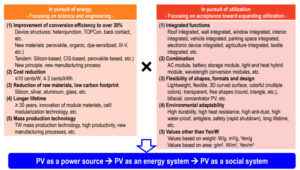The evolution and diversification of crystalline silicon (c-Si) solar cells and other PV technologies are accelerating. PV EXPO 2023, held in March 2023 in Tokyo, was an exhibition where the transition to a new era of solar cells was highlighted, as PV products responding to various situations and needs emerge. Following the second-generation p-type single-crystalline silicon (sc-Si) (PERC) solar cells, which became the mainstream after the first generation mainstream of multicrystalline silicon (mc-Si) solar cells, the dawning era of the third generation of n-type sc-Si solar cells (TOPCon, heterojunction (HJT) and back contact (xBC)) arrived. Now, the next-generation solar cells,represented by perovskite and tandem type solar cells, are emerging.
Among c-Si solar cells, the market share of sc-Si products has expanded rapidly from 19% in 2015 to over 90% in 2022. Over the next 10 years, the mainstream technology for solar cell device structure is expected to shift from PERC to TOPCon technology and the share of new cell technologies including HJT, xBC and tandem type, is expected to increase from the current approximately 20% to approximately 90%. Most of the exhibitors at PV EXPO displayed PV modules with large output capacity ranging from 600 to 700 W or more, made using large wafers (182 mm square and 210 mm square) and high conversion efficiency cell technologies. Further reduction of power generation costs are expected by improving power generation performances and reducing system costs. At the exhibition, wide variety of products for various applications were also presented to meet the needs of installers, such as compact modules for narrow and complex-shaped roofs in urban areas, building-integrated PV (BIPV), colored and decoratively designed products with minimal output decrease, ultralightweight and thin semi-flexible modules, etc.
Concerns are also growing worldwide about the overdependence on the supply chain for PV components in a limited number of countries and regions and the movements toward restructuring the PV manufacturing industry are gaining momentum in Europe, the USA and India. Including the measures such as the Inflation-Reduction Act (IRA) of the USA, the Production Linked Incentive Scheme (PLI) of India and the phased introduction policy of the Carbon Border Adjustment Mechanism (CBAM) of the European Union (EU), national governments are actively working on trade policies and domestic PV production to ensure energy security, create domestic jobs and address human rights issues, etc.
In Japan, in addition to the national R&D support projects such as the Project for the Green Innovation Fund, the development is underway utilizing the technologies and manufacturing expertise that have been developed with solar cells, liquid crystals and other materials. Regarding the exit strategy for perovskite and other next-generation solar cells, the following are anticipated: in-house production in Japan, licensing business for commercialization and production while retaining core technologies, collaboration with c-Si PV manufacturers on tandem type products, development of factories outside Japan, outsourcing of production, etc.
As shown in Figure 1, for expanding the use of solar cells, in addition to the conventional technology development that pursues energy from the perspectives of higher conversion officiency, lower cost, etc. (introduction capability), technology development that pursues utilization based on the needs of users and installers (utilization capability) will also become important hereafter. Depending on the types of solar cells that are being developed, it is expected that the range of PV applications and use will be separated and the utilization of PV power generation will be broadened. From now on, it will be also important to develop new markets not controlled by the perwatt unit price alone and to increase added value, through the fusion of technologies with industries in other fields, such as construction, agriculture, automobiles, aviation, infrastructure, telecommunications and consumer products. Diversification of markets (needs) and diversification of solar cells will work in tandem to create synergy that will lead to the development of markets and businesses.

Figure 1 Direction of the future development of PV products toward making PV a main power source
©RTS Corporation
Since solar cells have been evolving and diversifying in various forms rapidly in the 2020s, the future of PV power generation is bright as a sustainable main energy source needed for the world in the future. In Japan, domestic companies are withdrawing from the production of c-Si solar cells one after another. However, to keep up with the rest of the world, it is time to show our technology development policy for the restructuring of the PV supply chain, considering the technology development of solar cells and the next industrial development, without stopping the development of PV technologies that is about to grow. The global and Japanese markets for PV power generation toward 2030 are expected to evolve and progress significantly as they enter the mass introduction phase. Accordingly, it will be necessary to revise the strategies for long-term technology development with a view to 2050, from the perspectives of both pursuing energy and pursuing utilization, as well as from the perspectives of industrial policy in addition to energy policy. We must combine the technology and knowledge we have accumulated so far with the power of the younger generation and digital technologies in order to take PV power generation to the next stage of growth, while Japan keeps excellent capability of PV technology development.
